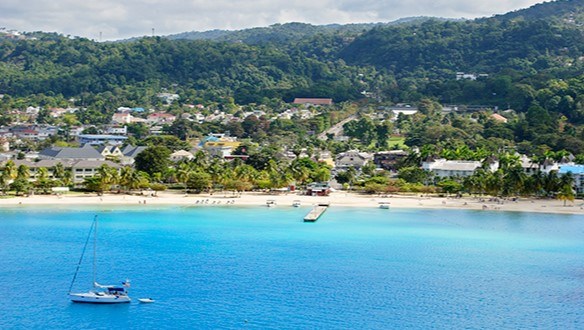
Turquoise blue seas and white sandy beaches, surely this is everyone’s iconic image of what the Caribbean is, and it is so true, one of our customers recently returned from the Caribbean, visiting there for the first time, came in to tell us, ‘it was just like it looks on Death in Paradise!’. Whichever Caribbean island you visit, you will almost certainly be greeted by delightfully friendly locals, warmly welcoming you to their beautiful island. During your stay you will laze on white sandy beaches, swim in turquoise blue seas, see lush green rainforests, witness incredible idyllic sunsets and simply relax, relax, relax.
Jamaica is the island of happy days, vivid nights and a place where your Caribbean dreams can come true. Paradise in Jamaica can be whatever you want it to be – lose yourself in the adventure and take it all in; get back to nature in the magic of the rainforests; hike the Blue Mountains and look at the world through new eyes; meet the friendly Jamaican people, try the food and watch the sunset over the Caribbean Sea to the sound of slow reggae rhythms. There is something for everyone, take a look at the video and read on to discover more.
The Rio Nuevo, a small river that trickles down from the hills of the parish of St Mary, lends its name to the small village on the coastline where the river enters the sea. Few people realise how important this small, quiet suburb of the large resort town of Ocho Rios is to Jamaica’s history. In the 17th century, while European nations fought over the control of various areas in the New World, the English wrestled the island of Jamaica from the Spanish, then the dominant Colonial power in the region. At Rio Nuevo in 1658, the most definitive battle between the English and the Spanish over the control of Jamaica took place and, as a result, after a mere 150 years of Spanish rule, the British were able to capture the island.
Rio Nuevo lies along the north coast highway, marked by a few small signs erected by the Jamaica National Heritage Trust identifying the site of the Battle of Rio Nuevo. On the actual battlefield site there is a monument to all the Jamaicans, both of African and Spanish descent, who fought the invading British valiantly albeit unsuccessfully. Today it is hard to imagine the carnage and bloodshed that brought the small community to the public forefront, since the site is now a grassy park dotted with shady trees and benches where visitors may sit and gaze at the horizon.
One of Jamaica's national treasures is Dunn's River Falls. There are few places where the Arawak name "Xayamaca", land of rivers and springs, is more apt and it is truly one of the most beautiful spots on the island. Described as a living and growing phenomenon, it continuously regenerates itself from deposits of travertine rock, the result of precipitation of calcium carbonate from the river, as it flows over the falls. The small dome-shaped cataracts are usually associated with thermal spring activity found in limestone caves. This, combined with its location near to the sea, gives Dunn's River the distinction of being the only one of its kind in the Caribbean, if not the world.
Sitting on 11 lush acres in the capital city of Kingston, the stately Devon House mansion was the home of Jamaica’s first black millionaire, George Stiebel. It was built in 1881, on what was originally a 51-acre property.
You will go back in time with a tour of the Georgian-style great house. Furnished with a collection of 19th-century antiques from Jamaica and the Caribbean region, the house tells the tale of privileged West Indian society in the Victorian era. The ballroom still has the original English chandelier purchased by Stiebel for the room. The finely crafted wooden Devon House is even more remarkable given that it was constructed by a man whose background made his climb to success particularly difficult. George Stiebel, the son of a black housekeeper and a German-Jewish merchant, made his fortune from investments in gold mines in Venezuela.
Today, the old stables, kitchen and other buildings on the property host some of Jamaica’s finest restaurants, confectioneries and souvenir shops.
Jamaica's World Heritage Site, the Blue and John Crow Mountains National Park, is one of the richest biodiversity sites in the world and a nature-lover’s paradise. It is home to over 1,300 flowering plant species, the largest butterfly in the Americas, the 6-inch Giant Swallowtail and over 200 species of native and migratory birds. The broadleaf forest bears the footprints of two of the oldest communities in the Caribbean, the Amerindian Taino and the Windward Maroons.
The national park covers over 100,000 acres in eastern Jamaica and includes Jamaica's highest point, the Blue Mountain Peak at 2,256m. You can enjoy nature walks and hiking, birdwatching, camping and stays in wood cabins complete with fireplaces.
There is a museum dedicated to the memory of the late Reggae superstar, Robert "Bob" Marley which is well worth a visit. It is located in Marley's original studio where he recorded many of his songs.
July 1, is recognised as International Reggae Day, 24 hours of celebration for reggae culture and its influence on Jamaican music. Hosted in Kingston, this is a celebration of the best of Jamaican creativity and its worldwide impact using the power of music, media and communication technology to unite nations.
So, if you have visited the Caribbean before, we have surely inspired you to return and if you have never been, surely you now want to go? Whichever it is, please get in touch and we will help you turn your Caribbean dream into reality.